#and i know all answers are no but
Explore tagged Tumblr posts
Text
24K notes
·
View notes
Text
I mean I get that’s it’s not the only contributing factor, but I’m curious exactly how much of the shelter dog over-population problem is actually due to poor dog ownership/management vs the housing crisis and economical stress. I’d be willing to bet by investing in social programs that give people the resources they need to care for their pets (cough cough affordable and free housing cough cough) that the amount of pets in shelters would dramatically drop. We can all sit here pointing fingers and screaming at each other until we are blue in the face, but if the owners basic needs are not being met, how can we hold them to a basic standard for their pets?
#I know I’m probably preaching to the choir#but truly it feels like we got one group of ppl being like#adopt don’t shop! people breeding animals are evil!#and the other side being like#alll shelter dogs are inherently genetic disasters that will always have behavior issues responsible breeding is the answer#or the problem is uneducated owners#idk guys we r all ripping ourselves apart when the real enemy#*turn and looks directly into the camera*#is our government#USA centric post
7K notes
·
View notes
Text
i desperately need people to realize there's a difference between "women need to coddle (cis) men's feelings even when they're being misogynistic uwu" and "we shouldn't tolerate misogyny but actively keeping men separate from women and treating them like they're inherently dangerous to women is only going to worsen the problem (and also this mindset causes IMMEASURABLE harm to nonbinary, trans, and intersex people, who are already incredibly at risk right now)" and i need people to realize that NOW
#misogyny#transphobia#intersexism#marshy speaks#ask to tag#like your 'hate all men' radfem shit is only worsening the problem i'm sorry.#unfortunately i don't have an easy answer for how to deal with this problem nor do i think there is an *easy* answer#but i sure as fuck know that gender essentialism is not it lmao
3K notes
·
View notes
Photo


what'd she mean by that 🤔 missed the vtmb vampire lesbians so
pandora (girl with beanie) belongs to @napelf
#ocs#personal art#gift art#i will not answer questions at this time goobye#marilyn loves pythons is all u need to know
35K notes
·
View notes
Text




We didn't even get an answer, and we never will (at least it's not determination)
FIRST - PREVIOUS - NEXT
MASTERPOST (for the full series / FAQ / reference sheets)
#deltarune#undertale#utdr#crossover comic#undertale fanart#deltarune fanart#art#twin runes#twin runes comic#kris dreemurr#frisk#chara#ralsei#aaaaah chara is slowly figuring out what they are#are you onto it too?#but I'm with susie let's get on with the story already!#for those who haven't picked up on it#this comic and the last one are poking fun at the whole “what does the red soul represent” debate in the fandom#especially under the last comic i've seen people viciously arguing with one another on other platforms#or people from both camps yelling at me#fact is we know that every human soul has determination due to the log entries in the true lab and the amalgamates#some humans just can have more and others less of it#that is what chara is pointing out about kris specifically#they have a red soul but less determination than most humans#the comic ends on a non-answer because unless we get toby's word on it we will never know what it is#and that is kinda a toby fox move#we will never get his answer#all we can do is theorize#personally I like to think it's love#especially in the context of this comic series
4K notes
·
View notes
Text

An important FNAF question, why is Michael purple?
#myart#chloesimagination#comic#michael afton#abby schmidt#mike schmidt#fnaf#fnaf movie#sister location#fnaf fanart#five nights at freddy's#MIKE KNOWS the actual answer#and did not want Abby to know#so Michael lied the best he could 💜#I wanted to draw Michael and Abby again getting along#her new older brother after all#just them and sibling shenanigans 💜💜
11K notes
·
View notes
Text
i'm one hundred percent certain that after percy and annabeth made out underwater. and he wanted to make their relationship official. the question was not "will you be my girlfriend?" but "can i be your boyfriend?" i don't care what the canon says. percy gave annabeth the space to take the lead in the relationship. because after a lifetime of being abandoned by everyone she dared to care for. and then watching her on the brink of a panic attack at the thought of losing him the last four years. he wanted to honor a new beginning between them by follow her lead and moving at her pace.
#i will not accept another answer#(i'm easily persuaded)#i don't care what the canon says#(unless it was exactly this in which case that was good story writing)#percy jackon and the olympians#pjo text post#pjo#pjo headcanon#percy jackson#annabeth chase#percabeth#percabeth headcanon#percabeth fluff#percabeth cute#percabeth romantic#percabeth rant#but in all seriousness#he for sure did this#not bc annabeth is a controlling partner like percabeth-opposers claim she is#but bc she is a girl who experiences love the same way the moon feeds off the suns reflection#never knowing truth warmth#only it's echo#and percy intends to make her feel like she's his entire world#like she's the reason the sun shines so brightly#so fuck off
3K notes
·
View notes
Text
going through my old journals as part of therapy homework and i'm reading a section written in the emotional wreckage of a full-on breakdown when i get hit with this line:
There is never a satisfying answer to ‘Why didn’t they love me?’
like wow babe. good fucking point
#like you were on the ground biting the carpet and dry sobbing while you wrote that and still. good fucking point#not a shitpost#cptsd#and it's true. there's never a satisfying answer#the truth is i know why i wasn't loved#i analyzed my parent's traumas and abuse to death. i understand why i alienated and was alienated from my siblings#i know why my mom was too overwhelmed to be capable of nurturing#i know why my dad vanished into addiction and avoidance#the details of our cycles of trauma and cptsd and family history i have a phd in all of it#i understood perfectly. i spent years studying and now i knew the answer#and guess what? IT WAS NOT SATISFYING!!!#because they still didn't love me! and i still couldn't change that!#it was still a completely unsatisfying state of affairs!#so like. when the people who are supposed to love you...don't.#when the people who are supposed to take care of you...fail to#you can look for answers and reasons and explanations#but that's not actually going to FIX your situation.#and it's probably not within your ability TO fix the situation. (and definitely not your job)#because you don't need answers--you need a new situation#*inserts Just Walk Out. You Can Leave!!! (Running Skeleton) Meme*#and yes. walking out isn't always possible.#but for you i hope it will be one day soon. and i hope you build the courage to take that leap.#stepping away from the people who failed to love you...it feels like being untethered but also like being lighter than air#new and scary. immensely relieving. the future opens up. empty but empty like a canvas. blindingly bright until your eyes adjust#like climbing out of a pit you called home and for the first time realizing how bright the light of day can truly be#when you aren't just getting glimpses from the bottom of a hole
10K notes
·
View notes
Text

happy 9 years
here's to 990 more
#my art#undertale#chara dreemurr#asriel dreemurr#i would say ' would you believe me if i told you i started drawing this before the newsletter' but if you know me at all you would LOL#i don't have much to say this year. this is a continuation / answer to the one from last year#i don't tend to do 'finished pieces' like this these days but i can't eschew my tradition even if it was a bit like pulling teeth#it could have turned out worse lol#thanks undertale for keeping me alive and giving me most of the good things i still have
2K notes
·
View notes
Note
facts about you please
"You Please" is a 1978 novel by Frank Mutterbruder about a hypersexual woman's growing lust for an artist who is only interested in her as a model. The story concerns her attempts to seduce him as they grow more and more outlandish and dangerous. The book's graphic sexuality and implied cannibalism caused it to be banned in several states, though the publisher, Grovemeat Press, appealed and won at the federal level.
Mutterbruder was likely inspired by his older friend, Frankie Powers-Jovani, a famous gay artist known for his Tom-Of-Finland style works depicting men in leather with large, round muscles and other bulging parts. Powers-Jovani had worked with a model, assumed by some to be Bettie Page (though no evidence of this exists) on an unreleased series, said to have been destroyed by either Frankie or the model upon their feud.
The book departs from reality however when its protagonist, Jessica Jellie, creates a love potion to make her artist friend love her back. She mixes the potion wrong and accidentally creates a fluid capable of melting men into a delicious putty. After killing the artist, she begins melting other men and serving the putty as a sort of cake fondant that she sells under the name of "Manzipan."
Frank Mutterbruder died in 1982 when he was himself melted into putty during the Pittsburgh Play-Dough Calamity. His novel has gone largely ignored until recently, when Yorgos Lanthimos optioned it with Emma Stone to play Jessica Jellie and Colin Farrell as artist Yakov Geww.
The original printing of the novel "You Please" also won the Albert A. Gore Award for Most Recyclable Paper, but this is generally considered irrelevant to its literary significance.
#i dont know why i typed all this as an answer to that#i guess this is why i have the blog#my brain is FULL of useless made up bullshit#it just pours out sometimes#unreality
3K notes
·
View notes
Photo

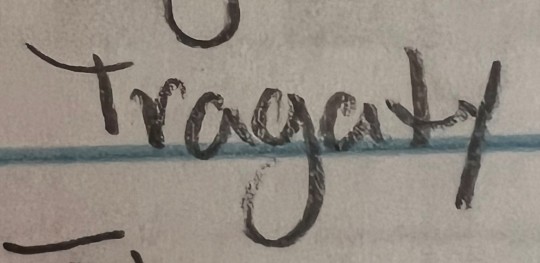
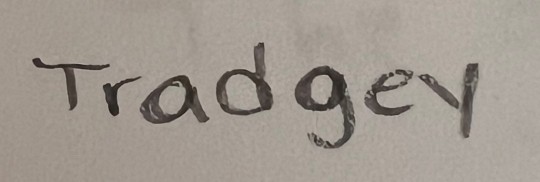
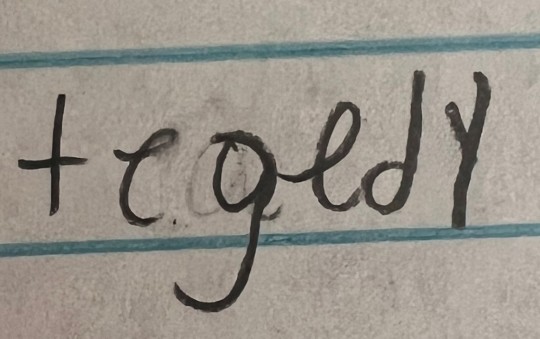
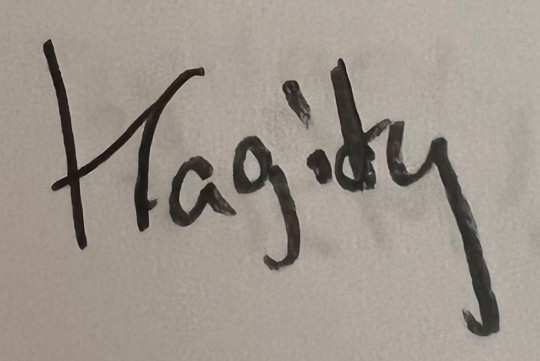
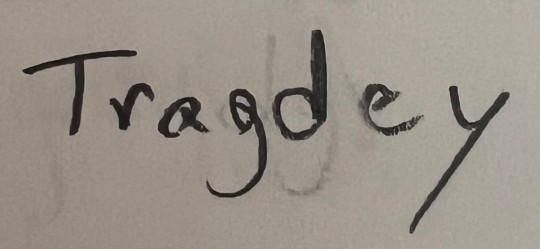
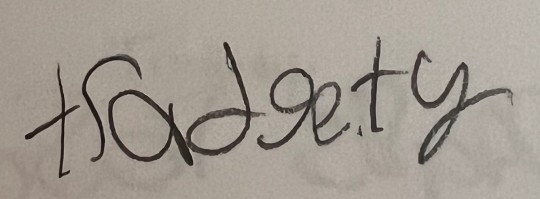


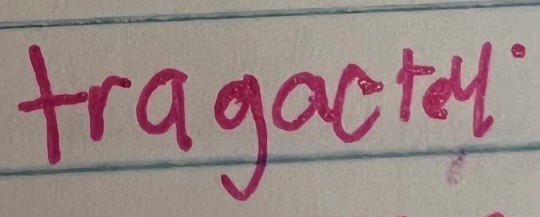
My students’ adventures in trying to spell “tragedy” for their Romeo and Juliet quiz.
#on the bright side... they did know the correct answer#i love them all to death#grading their handwritten work is an adventure though#teacherblr#teacher life#teaching#english class#english teacher#literature#grammar#romeo and juliet#william shakespeare#shakespeare#tragedy
13K notes
·
View notes
Note
Sans do you ever feel that something might be missing?


Maybe he felt like that at some point, maybe for a long time. In the present, I think he's made some kind of peace with it.
Also, I really like the ask blog format, but I don't really mean this to be an ask blog.
So when writing questions, try to refer them to me instead of the characters. That way, they don't have to break the fourth wall lmao. I really wanted to answer this one tho
-
#forgettable-au#YOU WANT TO KNOW WHAT TAKES ME THE MOST WHEN MAKING THSES THING#I CANNOT WRITE#Everythings so clear to me and then I have to write it and I get stuck#illustrating it all feels so much easier even when it takes more time#maybe it's just because english isn't my first lenguage#but I'm always checking my orthography and punctuations are correct alsjsdk#papyrus!gaster#papyrus#undertale au#sans#papyrus is gaster#alphys#undyne#toriel#undertale comic#undertale#I JUST REALIZED I FORGOT TO DRAW FLOWEY NOOOOOOOOOOOOOOOOOOOOOOOOOOOOOO#my boy...#answered ask
7K notes
·
View notes
Note
hina... have you ever drawn nanami & yuji. pls i need to see them. my reluctant mentor and ray of sunshine. maybe eating together after a mission

cleaned up this request doodle from a while ago <3
#my art#answered#anonymous#jujutsu kaisen#jjk#jjk fanart#nanami kento#yuji itadori#jujutsu kaisen fanart#sorry for getting to this so late anon :'<<<<#also sorry the art technically isnt new shkdg i tried to come up w a different setting fr them#thought abt them going fr ramen or something ? like an izakaya scene#but i wasnt happy w any of my sketches n took the easy way out gomen gjdghjj#i hope u still like the cleaned version!#well . “clean” gjhgssgj yuuji sweetie do u need a napkin#both of these pastries r based off ones we sold at the bakery i used to work at#u know . the one that put me into a 7 month depressed artblock n made me want to kms/srs#and speaking from experience. those filled croissants r not user friendly#crumbs + cream + fruit + syrup drizzle + chocolate...all EVERYWHERE smh#also nanami's looks like a cookie but it's not i promise. it is a raisin danish bc he has th palette of an old man at 27
931 notes
·
View notes
Text
Bonus round! Do you use a queue tag?
#ive been super curious about this because people seem to have really strong opinions on the queue! so many people seem to HATE it#but i love using the queue! i dont really know exactly why i like it so much- i started using in like... 2016 and its a fundamental part of#my tumblr experience now. i think i started off just using it for offline hours so id hit most my american mutuals (/ for aes posts)#but these days basically everything goes in my queue (cept time sensitive things & like. current hype and original posts-#anything 'normal' posting is in the queue)#idk it feels. nice to me! i like to spread out my posting and not rb 30 things in half an hour and then disappear for the rest of the day#esp since my spaces are so circular- the same post runs on my dash a dozen times minimum. and i get to put it on ur dash a week late!!!#and its so nice to have small interactions with mutuals in incompatible timezones; to open up my notifications in the morning#and go: oh! my friends were here <3#its such a Part of the tumblr experience for me i dont think i could ever truly change now. maybe switch to timed queueing#but my availability changes so much i prefer to just. know i guess#but (i am so sorry for all that) im curious about how other people feel!!!!!! itd be so interesting to hear abt why people do/do not like i#i know some people like the experience of spamming and going. some people think it makes this seem to much like influencing or whatever#everyone has their reasons and i want to know!!!!!!!!!!!!!!#nyxtalks#poll#queue#no see answers option because you must fall into one of these
1K notes
·
View notes
Text
Something about how loudly Edwin says Charles' name in this scene has been driving me insane and I think I've finally figured out why.
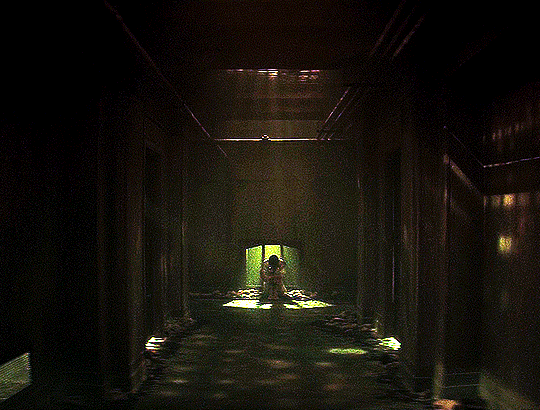
When Charles finds Edwin in hell, Edwin is rolled into a little ball of misery, covered in blood and quietly sobbing. It's probably a position he's developed over decades, making himself as small as possible, being as quiet as possible, trying to take up as little space as possible. He's almost pretending he doesn't exist in order to stretch out the moments before the spider finds him and the loop starts again.

And then Charles says his name and Edwin looks up and sees Charles, and it's like all of his defenses just vanish. He doesn't whisper Charles' name, he says it, loudly, as if he has completely forgotten where he is and that they need to be quiet. He gets up, unfurls his limbs, slowly standing up to his full height, taking up space again. Every instinct in his body should tell him to stay hidden and as invisible and silent as possible, but Charles has just smiled at him, and Edwin speaks again, asking "Is that you?" and letting out a shaky breath of relief.


He is completely vulnerable and exposed now, like Charles' arrival has made him completely forget that they are in hell and that he could be ripped apart by a spider doll demon at any moment. All the defences he has built up over literal decades just completely crumble as soon as he hears Charles' voice.


And then the spider comes and rips him away, and I don’t think it would have done (at least not yet), had Edwin not alerted it to his presence like that. I think that’s why this moment wouldn’t let go of me, because I always thought it shouldn’t be this easy for Edwin to abandon a survival tactic he has developed over decades of torture. But all it takes is Charles being there, and Edwin forgets everything else.
#this moment has been like a puzzle I've been trying to solve and the answer was just payneland all along#dead boy detectives#dbda#edwin payne#charles rowland#payneland#give George all the awards for this moment alone#also these gifs are not mine but I don't remember where I got them from so if you recognize them let me know so I can credit the creator#my post
956 notes
·
View notes
Text

“Which sibling tried to kill Luffy?”
#asl brothers#portgas d ace#sabo#monkey d luffy#uta#asl + uta#uta one piece#one piece#one piece fanart#;; my art#skialdi art#digital art#anime art#fanart#long time no background#I love these four and this drawing is endlessly amusing to me#please enjoy them being a meme and bullying ace#when we all know what the true answer is
6K notes
·
View notes